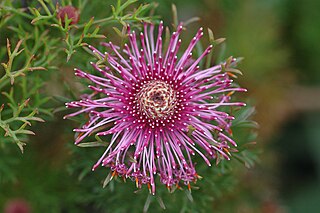
Isopogon formosus, commonly known as rose coneflower, is a species of flowering plant in the family Proteaceae and is endemic to the south-west of Western Australia. It is a shrub with divided leaves with cylindrical segments, and spherical to oval heads of pink or red flowers.

Banksia armata, commonly known as prickly dryandra, is a species of often sprawling shrub that is endemic to Western Australia. It has deeply serrated leaves with sharply pointed lobes and spikes of about 45 to 70 yellow flowers.

Banksia erythrocephala is a species of prickly shrub that is endemic to Western Australia. It has erect stems, sharply pointed pinnatifid leaves, cream-coloured and reddish black or all cream-coloured and yellow flowers, and egg-shaped fruit.
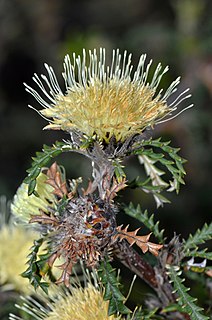
Banksia kippistiana is a species of shrub that is endemic to Western Australia. It has linear, pinnatifid leaves with ten to twenty lobes on each side, heads of up to eighty yellow and cream-coloured flowers, and elliptical follicles.
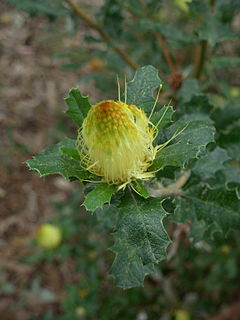
Banksia undata, commonly known as urchin dryandra, is a species of shrub that is endemic to the southwest of Western Australia. It has sessile, wedge-shaped, wavy, serrated leaves, pale yellow flowers in heads of between 80 and 160, and later up to eight follicles in each head.
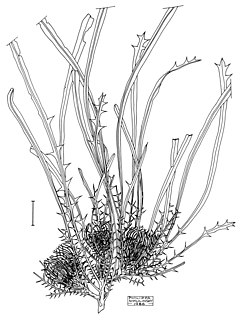
Banksia subpinnatifida is a species of bushy shrub that is endemic to the southwest of Western Australia. It has more or less linear, pinnatipartite leaves with sharply-pointed teeth on the sides, golden yellow flowers in heads of about sixty, and glabrous, elliptical follicles.
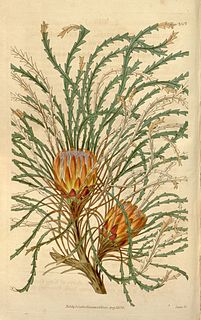
Banksia tenuis is a species of shrub that is endemic to the southwest of Western Australia. It has pinnatifid, serrated or smooth-edges leaves, golden brown and cream-coloured flowers in heads of about fifty-five and glabrous, egg-shaped follicles.

Lambertia multiflora, commonly known as many-flowered honeysuckle, is a multi-stemmed shrub which is endemic to the south-west of Western Australia. It grows to between 0.5 and 2.5 metres high and flowers from winter to summer.
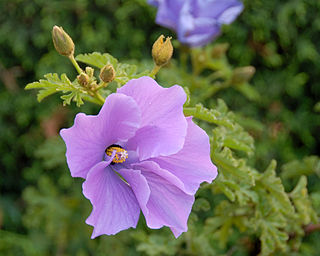
Alyogyne huegelii is a flowering plant found in the Southwest botanical province of Western Australia, extending along its entire coastline. A large flowered shrub, the species favours the sands of coastal shrublands and heath.

Banksia undata var. undata is a shrub endemic to Western Australia.

Banksia sessilis var. cordata is a variety of Banksia sessilis, with unusually large leaves and flower heads. It is a rare variety that is restricted to the extreme south-west corner of Western Australia.
Banksia sessilis var. flabellifolia is a variety of Banksia sessilis.

Grevillea hookeriana is a shrub species in the family Proteaceae. It is endemic to the south west region of Western Australia.

Lambertia inermis, Noongar chittick, is a shrub which is endemic to south-west Western Australia. It grows to 6 metres high and flowers from spring to winter. A more complete description is given in Florabase and Australian Flora online.

Eremaea pauciflora is a plant in the myrtle family, Myrtaceae and is endemic to the south-west of Western Australia. It is a shrub with small leaves and orange flowers at the ends of its branches. It has the most widespread distribution of the eremaeas with considerable variation in its characteristics so that three varieties are recognised. It was the first Eremaea to be described formally but was not originally given the name Eremaea.

Isopogon buxifolius is a species of plant in the family Proteaceae and is endemic to the south-west of Western Australia. It is an upright shrub with egg-shaped to elliptic or oblong leaves and clustered spikes of pink flowers.

Verticordia densiflora, commonly known as compacted featherflower, is a flowering plant in the myrtle family, Myrtaceae and is endemic to the south-west of Western Australia. It is a shrub with small leaves, usually small pink and white flowers and which is widespread in the south-west of the state. It is a variable species and in his 1991 paper, Alex George formally described five varieties.

Conospermum nervosum is a shrub of the Proteaceae that is endemic to Western Australia.

Trymalium ledifolium, sometimes called Star Buckthorn, is a plant species in the Rhamnaceae family, found in the south-west of Western Australia. It is a shrub which grows from 0.3 to 2.5 m high, and grows on clay, gravel, loam and sand, on granite, limestone and laterite and on outcrops and dunes. Flowering from June to November, the flowers are a white-cream.
Hibbertia pulchra is a species of flowering plant in the family Dilleniaceae and is endemic to the south-west of Western Australia. It is a multi-stemmed shrub with clustered, linear to narrow egg-shaped leaves with the narrower end towards the base, and yellow flowers with eleven stamens arranged around three carpels.
















